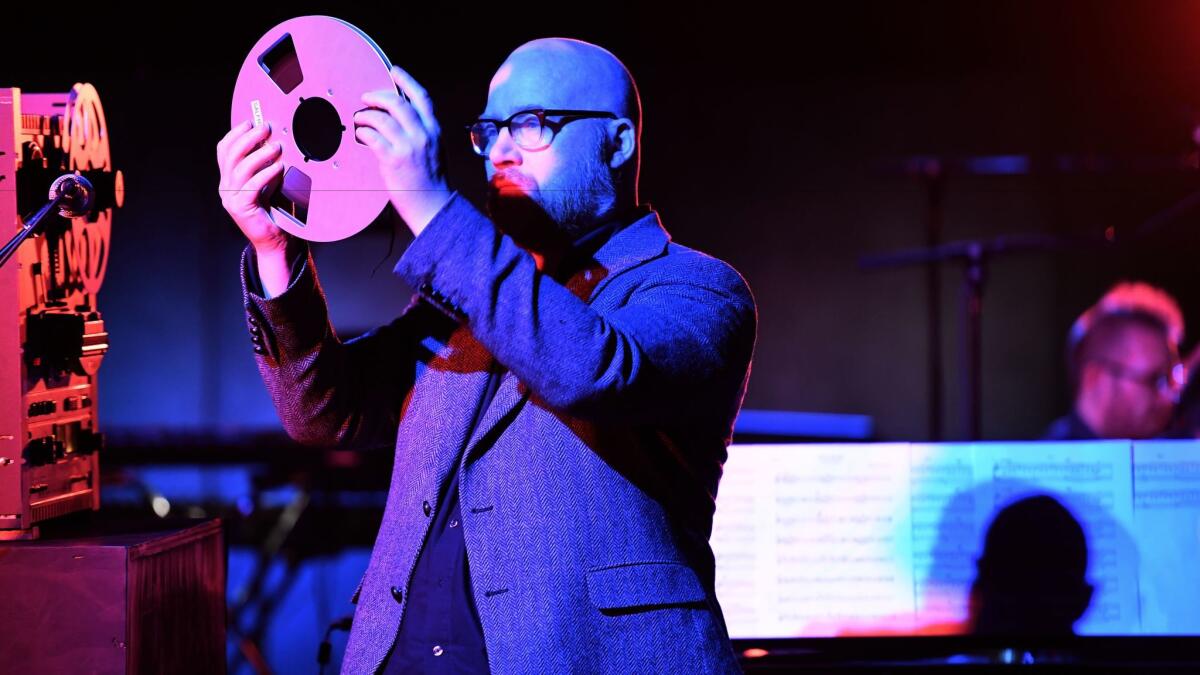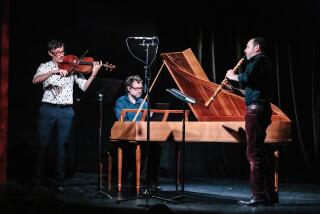Column: With Jóhann Jóhannssson and Bedroom Community, L.A. Phil tries to break through the Icelandic cliches

A piece of wood whispers in the ear of a storyteller, who recounts a ship in Greek myth skimming the ocean’s surface, gliding between sea and sky as Orpheus strums his lyre. Singer and song, so writes Icelandic novelist Sjön in “The Whispering Muse,” affect “a new verb that combined the verbs ‘to come’ and ‘to go,’ at once both mother and womb.”
The music of Iceland, heard over a week in the Los Angeles Philharmonic’s Reykjavík Festival that largely ended at Walt Disney Concert Hall on Monday night with Hollywood composer Jóhann Jóhannsson, was indeed the music of coming and going. (“Björk Digital” is still to come next month with a VR exhibition and a sold-out concert with the singer and orchestra May 30.) Some works skimmed the surface. Others produced the hardly unpleasant effect of diving into a self-sustaining sonic environment, if maybe more varied Biosphere 2 than smothering womb.
A lot of the music sounded, to non-Icelanders, the same. Acoustic and electronic drones abounded. The music in the week’s worth of concerts I caught was often whispering quiet, repetitive, uncertain and slow. Some of it, especially from the rock band Sigur Rós over the weekend, was repetitive and slow, but loud. Here the build-up of volume seemed a device to outwit uncertainty. Coming and going, coming and going, as the rhythm of Orpheus’ lyre, again to quote Sjön, meant to “cause the monsters of the deep to flinch away.” The oarsmen row, back and forth, “as if grappling with an energetic bedmate.”
Is sex all there is to it? Reykjavík doesn’t have trees, and before 1984 it outlawed dogs. But it does have the reputation as one of the sex capitals of Europe. Could the answer to the great question of how a tiny population on the distant, northernmost island in Europe — once among the poorest countries on the Continent — has such an outsized affect on the world’s music scene be this insipid?
In preconcert talks, we were repeatedly cautioned against the cliché of attributing the strange allure of Icelandic composers to the unique landscape. That’s journalistic shorthand for not having anything to say about the music, even though that and the weather are the main things the composers themselves end up talking about. There is also in this music a seeming preoccupation with the past — the analogue sound world near past and the mythic past — as well as an obsession with the digital present.
Where do all the drones come from? Who knows, maybe the fact that many composers come to the West Coast and pick the drones and repetitions up from our music. Musically, Brooklyn, with its love of the backbeat, is only a local call away from Reykjavík. New York and Icelandic composers have bonded, most notably in the Bedroom Community, a home recording studio in Reykjavík that has turned into an international composer and performer collective. It also appeared at Monday’s concert.
Something else came up during the festival that very much distinguishes Iceland from the U.S., namely the lavish state support for arts education. Furthermore, the Iceland Symphony is fully government funded, as was the building of Reykjavík’s celebrated modern concert hall, built during the country’s financial crisis at the end of last decade and opened in 2011.
And then there is simply the allure of music in a country with long, dark, cold winters. Reykjavík is small enough that everyone apparently knows a composer.
The take-away from the Reykjavík Festival is that the city’s music scene is a young scene. Most of the composers and performers were under 40. Given the quality of education (and also the fact that most Icelandic composers study in the U.S. or Europe and then return home) and the support for the Iceland Symphony (which regularly plays these young composers’ music), it wasn’t so surprising that the most exciting aspect of the festival was the orchestral works. Of course, this was a festival sponsored by the L.A. Phil, and it also had the considerable advantage of Esa-Pekka Salonen conducting.
Six orchestral pieces were played, two a night on the sold-out programs Thursday, Friday and Saturday that included Sigur Rós and that attracted the sophisticated pop fans for whom Coachella has become too commercial and crowded. Five of the pieces were new or recent. There was also the thrilling 1930 Organ Concerto by Jón Leifs, the only early 20th century Icelandic to gain any kind of international reputation. The concerto, which featured James McVinnie as the thundering soloist, is full of the German-trained composer’s massive, plundering dissonances.
How the new generation got from there to something like Haukur Tómasson’s glittering Piano Concerto No. 2, with Vikingur Ólafsson as soloist, or Maria Huld Markan Sigfúsdóttir’s darkly sonorous “Aequora,” or Anna Thorvaldsdóttir’s ethereally teeming “Aeriality,” is anyone’s guess, but Reykjavík does happen to be a city that modernized seemingly overnight.
Each composer has an ear for texture, color and an original sound world. Icelandic music has also been characterized by slow progress, but what was so satisfying about these works was that, slow and mysterious, they valued intriguing process over commonplace progress.
That left Monday’s concert, which began with the Bedroom Community’s Whale Watching Tour. The collective mixes the likes of the musically omnivorous New York composer and pianist Nico Muhly with New York folksinger Sam Amidon, along with Icelandic musicians and composers, notably Valgeir Sigurdsson and others from New York, Britain and L.A.
Muhly is the standout here for his piano pieces and playing. Elsewhere there was a lot of jiving in various arrangements that included Sigurdsson’s moody yet surprising electronics, but also mismatches, as with Amidon.
There is no mix-matching in the slick, New Agey pieces that Jóhannsson played on keyboards accompanied by the string quintet Acme. Jóhannsson has become a danger sign for Icelandic musicians drawn to Hollywood. In a very short time, he has gone from creating effectively evocative soundtracks to films like Bill Morrison’s gripping “The Miner’s Hymns” to major mainstream features as “Arrival.” He is the composer of four films now in post production, including “Blade Runner 2049.”
At Disney he pretentiously beat the same melodic or harmonic formulas into endless submission with background of syrupy strings and electronics. He majestically put tapes on a classic reel-to-reel machine, although it was impossible to tell what was on those tapes as opposed to what was digitally manipulated. An oarsman rowing back and forth, but staying in one sexless place.
No, sex is not the answer. But when it comes to Reykjavík’s vibrant music scene, the clichés of landscape gladly expel those of Hollywood.
ALSO
Sigur Rós rocks the L.A. Phil in the name of Reykjavík
Reykjavík Festival begins with singing into teacups
Philip Glass, Pat Metheny, k.d. lang, Audra McDonald all turn out for a tribute to a Nonesuch guy
More to Read
The biggest entertainment stories
Get our big stories about Hollywood, film, television, music, arts, culture and more right in your inbox as soon as they publish.
You may occasionally receive promotional content from the Los Angeles Times.











